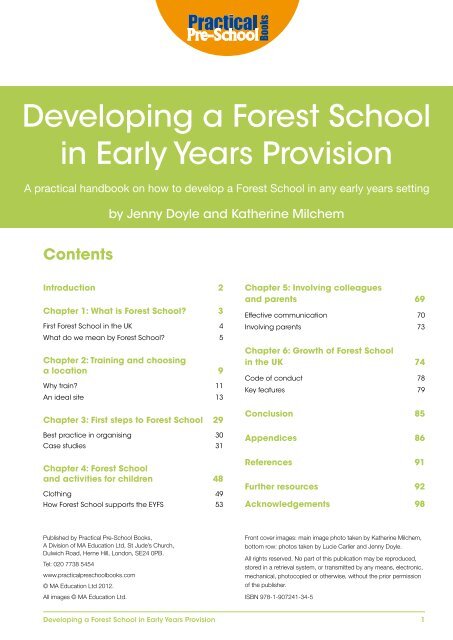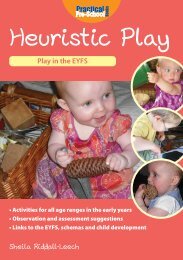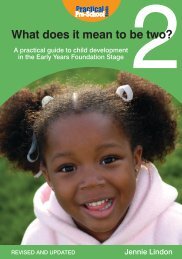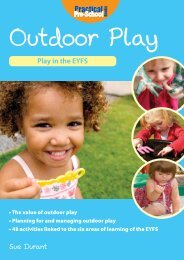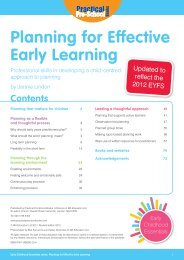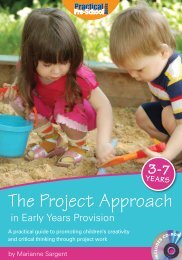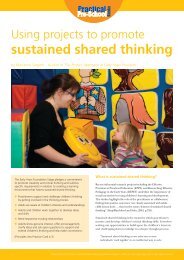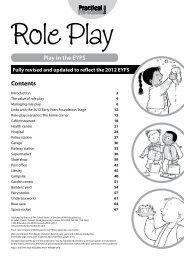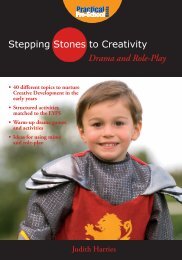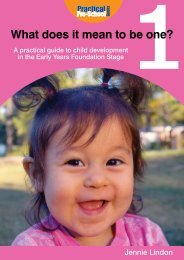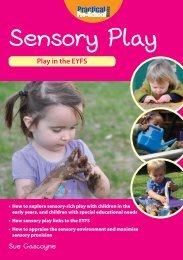Developing a Forest School in Early Years Provision - Practical Pre ...
Developing a Forest School in Early Years Provision - Practical Pre ...
Developing a Forest School in Early Years Provision - Practical Pre ...
You also want an ePaper? Increase the reach of your titles
YUMPU automatically turns print PDFs into web optimized ePapers that Google loves.
Books<br />
<strong>Develop<strong>in</strong>g</strong> a <strong>Forest</strong> <strong>School</strong><br />
<strong>in</strong> <strong>Early</strong> <strong>Years</strong> <strong>Provision</strong><br />
A practical handbook on how to develop a <strong>Forest</strong> <strong>School</strong> <strong>in</strong> any early years sett<strong>in</strong>g<br />
by Jenny Doyle and Kather<strong>in</strong>e Milchem<br />
Contents<br />
Introduction 2<br />
Chapter 1: What is <strong>Forest</strong> <strong>School</strong>? 3<br />
First <strong>Forest</strong> <strong>School</strong> <strong>in</strong> the UK 4<br />
What do we mean by <strong>Forest</strong> <strong>School</strong>? 5<br />
Chapter 2: Tra<strong>in</strong><strong>in</strong>g and choos<strong>in</strong>g <br />
a location 9<br />
Why tra<strong>in</strong>? 11<br />
An ideal site 13<br />
Chapter 3: First steps to <strong>Forest</strong> <strong>School</strong> 29<br />
Best practice <strong>in</strong> organis<strong>in</strong>g 30<br />
Case studies 31<br />
Chapter 4: <strong>Forest</strong> <strong>School</strong> <br />
and activities for children 48<br />
Cloth<strong>in</strong>g 49<br />
How <strong>Forest</strong> <strong>School</strong> supports the EYFS 53<br />
Chapter 5: Involv<strong>in</strong>g colleagues <br />
and parents 69<br />
Effective communication 70<br />
Involv<strong>in</strong>g parents 73<br />
Chapter 6: Growth of <strong>Forest</strong> <strong>School</strong> <br />
<strong>in</strong> the UK 74<br />
Code of conduct 78<br />
Key features 79<br />
Conclusion 85<br />
Appendices 86<br />
References 91<br />
Further resources 92<br />
Acknowledgements 98<br />
Published by <strong>Practical</strong> <strong>Pre</strong>-<strong>School</strong> Books,<br />
A Division of MA Education Ltd, St Jude’s Church,<br />
Dulwich Road, Herne Hill, London, SE24 0PB.<br />
Tel: 020 7738 5454<br />
www.practicalpreschoolbooks.com<br />
© MA Education Ltd 2012.<br />
All images © MA Education Ltd.<br />
Front cover images: ma<strong>in</strong> image photo taken by Kather<strong>in</strong>e Milchem,<br />
bottom row: photos taken by Lucie Carlier and Jenny Doyle.<br />
All rights reserved. No part of this publication may be reproduced,<br />
stored <strong>in</strong> a retrieval system, or transmitted by any means, electronic,<br />
mechanical, photocopied or otherwise, without the prior permission<br />
of the publisher.<br />
ISBN 978-1-907241-34-5<br />
<strong>Develop<strong>in</strong>g</strong> a <strong>Forest</strong> <strong>School</strong> <strong>in</strong> <strong>Early</strong> <strong>Years</strong> <strong>Provision</strong> 1
Chapter 1:<br />
What is <strong>Forest</strong> <strong>School</strong>?<br />
<strong>Forest</strong> <strong>School</strong> – two words that over the last fifteen years<br />
seem to have captured the imag<strong>in</strong>ation of early years<br />
practitioners and other educators all over the United K<strong>in</strong>gdom<br />
(UK). Much has been written about <strong>Forest</strong> <strong>School</strong> <strong>in</strong> various<br />
guises, but why has this form of learn<strong>in</strong>g become one of the<br />
fastest grow<strong>in</strong>g movements <strong>in</strong> education – probably more than<br />
any other <strong>in</strong>itiative <strong>in</strong> recent times? And why not driven from<br />
government but from grass roots: the practitioners? Questions<br />
frequently asked are: “What is ‘<strong>Forest</strong> <strong>School</strong>’? Do I need a<br />
woodland?”. Before questions like these can be answered, we<br />
need to explore why and where this form of learn<strong>in</strong>g orig<strong>in</strong>ated.<br />
<strong>Forest</strong> <strong>School</strong> <strong>in</strong> the UK can be traced back to 1930s when<br />
educators from the Woodcraft Folk, Quakers and the Order<br />
of Woodcraft Chivalry started promot<strong>in</strong>g the ‘Woodcraft<br />
Way’, a movement started <strong>in</strong> the early 1990s <strong>in</strong> America by<br />
Ernest Thompson Seton. The <strong>in</strong>fluence for this movement<br />
came from the beliefs and lifestyle of Native Americans and<br />
how they lived with and close to nature. In 1948 residential<br />
camps began with the aspiration to pass on the ways and<br />
values of these native people through liv<strong>in</strong>g outdoors and<br />
essentially community participation. It was the practical,<br />
hands on, positive and creative experiences that were felt<br />
necessary to appreciate nature that became the philosophy<br />
of the camps. Liv<strong>in</strong>g ‘<strong>in</strong> tune’ with nature was seen to k<strong>in</strong>dle<br />
an <strong>in</strong>ner feel<strong>in</strong>g of well-be<strong>in</strong>g and contentment. At camp,<br />
children are taught to care for themselves, each other and<br />
the environment: a sentiment reiterated <strong>in</strong> the recently<br />
published ‘Susta<strong>in</strong>able <strong>School</strong>s’ framework (DCSF 2008).<br />
The society that became <strong>Forest</strong> <strong>School</strong> Camps still arrange<br />
weekend and holiday camps for young people.<br />
More recently, what is now <strong>in</strong> education and environmental<br />
circles commonly known as <strong>Forest</strong> <strong>School</strong>, has been adapted<br />
from the Scand<strong>in</strong>avian approach to early years provision. In<br />
Scand<strong>in</strong>avian countries, just as <strong>in</strong> the UK, there is a variety of<br />
<strong>Develop<strong>in</strong>g</strong> a <strong>Forest</strong> <strong>School</strong> <strong>in</strong> <strong>Early</strong> <strong>Years</strong> <strong>Provision</strong> 3
CASE STUDY: f<strong>in</strong>land<br />
The nursery is situated on the edge of an office and<br />
light <strong>in</strong>dustrial estate. The <strong>in</strong>door space is a converted<br />
office conta<strong>in</strong><strong>in</strong>g a sleep room, kitchen and d<strong>in</strong><strong>in</strong>g space,<br />
a small baby room, various open-plan spaces with<br />
lots of books and natural materials. Outside is a<br />
veranda with coat pegs for outdoor cloth<strong>in</strong>g and boots.<br />
The outdoor space is not attached to the build<strong>in</strong>g but<br />
across the road and this is where the parents drop the<br />
children off <strong>in</strong> the morn<strong>in</strong>g.<br />
There is a picket fence with pegs where children hang<br />
their rucksacks. Each child br<strong>in</strong>gs a rucksack to nursery<br />
<strong>in</strong>clud<strong>in</strong>g; a flask conta<strong>in</strong><strong>in</strong>g a warm dr<strong>in</strong>k, a snack and a<br />
fold<strong>in</strong>g ‘sit upon’. The pedagogues greet the children <strong>in</strong><br />
the garden and the children are free to play immediately.<br />
The area has no grass or tarmac but is simply compacted<br />
soil. There are two fire pits with seat<strong>in</strong>g circles, a wooden<br />
shelter where the babies sleep dur<strong>in</strong>g the day, a wooden<br />
shed conta<strong>in</strong><strong>in</strong>g a first aid kit, skis (for w<strong>in</strong>ter) and simple<br />
equipment such as ropes and tools.<br />
After a few m<strong>in</strong>utes they move off and nursery children<br />
put away their flasks and cont<strong>in</strong>ue with their play. The<br />
pedagogue has a rucksack with basic equipment that<br />
the children can ask for if they wish to use it. After a<br />
while, two girls ask for paper and pencils to draw some<br />
flowers they have found. Another two ask for knives to<br />
do some whittl<strong>in</strong>g. They know exactly how to sit and use<br />
the knives.<br />
The children come together aga<strong>in</strong> later with flasks and<br />
bowls and sit on their mats. This time they take ‘d<strong>in</strong>ner<br />
gloves’ out of their rucksacks. (The weather is often too<br />
cold for the children to remove gloves for hand wash<strong>in</strong>g<br />
or eat<strong>in</strong>g and therefore by hav<strong>in</strong>g clean gloves they<br />
rema<strong>in</strong> warm, comfortable and reasonably hygienic.) The<br />
children help themselves to a bowl and serve themselves<br />
pasta and vegetable stew from the wide-neck flasks. The<br />
cook from the sett<strong>in</strong>g has produced the meal and br<strong>in</strong>gs<br />
it <strong>in</strong> a handcart to a designated area to be collected by<br />
the group. This happens every day.<br />
On this day, at 9am the key workers gather their children<br />
around the fire circles and discuss the day. The youngest<br />
children rema<strong>in</strong> <strong>in</strong> the garden area. The older group,<br />
five/six-year-olds, stay near the nursery, but outside of<br />
the garden, to have a creative day. This is still outside <strong>in</strong><br />
the public grassed area, which <strong>in</strong>cludes a large pond.<br />
The three- and four-year-olds head to the equivalent of<br />
<strong>Forest</strong> <strong>School</strong>. They collect their rucksacks and head off<br />
along a public footpath. The children are allowed to run<br />
ahead and have various landmark po<strong>in</strong>ts where they wait<br />
for everyone else.<br />
On reach<strong>in</strong>g ‘<strong>Forest</strong> <strong>School</strong>’, the children choose which<br />
area they go to. There are three areas, all public spaces.<br />
They choose ‘the rocky place’. There are quite steep<br />
slopes and rocks for them to climb but they all mange<br />
remarkably well. The children aga<strong>in</strong> are free to roam<br />
and explore. There are no physical boundaries but the<br />
children know their limits. They come together for snack<br />
and hot dr<strong>in</strong>k, which is provided by their parents. They<br />
all manage their own flask and pour their own dr<strong>in</strong>k.<br />
This is a social time with lots of conversation between<br />
friends. Another class of students, this time teenagers,<br />
arrive and sit close by for their snack. Neither group<br />
takes any notice of the other. The teenagers are quiet<br />
and respectful.<br />
After lunch, the lead pedagogue takes a small lantern<br />
from his rucksack and lights a tee light. He builds up<br />
the anticipation of a story by <strong>in</strong>vit<strong>in</strong>g an imag<strong>in</strong>ary fairy<br />
to jo<strong>in</strong> the children.<br />
After listen<strong>in</strong>g to today’s story, everyone collects up their<br />
belong<strong>in</strong>gs, plates and flasks and heads back down to<br />
the path and the await<strong>in</strong>g cart. Aga<strong>in</strong> the children are<br />
allowed to run on ahead, wait<strong>in</strong>g at the usual landmarks.<br />
On return<strong>in</strong>g to the nursery the children take off their<br />
outdoor cloth<strong>in</strong>g, go to the bathroom and strip to their<br />
thermal underwear. They climb <strong>in</strong>to giant multi-person<br />
bunk beds where they have an afternoon rest.<br />
<strong>Develop<strong>in</strong>g</strong> a <strong>Forest</strong> <strong>School</strong> <strong>in</strong> <strong>Early</strong> <strong>Years</strong> <strong>Provision</strong> 19
Chapter 3: First steps<br />
to <strong>Forest</strong> <strong>School</strong><br />
Organis<strong>in</strong>g <strong>Forest</strong><br />
<strong>School</strong> sessions<br />
<strong>Develop<strong>in</strong>g</strong> a <strong>Forest</strong> <strong>School</strong> programme is an<br />
evolutionary process, often becom<strong>in</strong>g more established<br />
as the practitioners and children develop their skills<br />
and knowledge. When develop<strong>in</strong>g a <strong>Forest</strong> <strong>School</strong>,<br />
it is important to look not only at where the child is at,<br />
but also assess the skills and knowledge of families<br />
and the sett<strong>in</strong>g itself.<br />
<strong>Forest</strong> <strong>School</strong> provision will differ from sett<strong>in</strong>g to sett<strong>in</strong>g, and<br />
will be as unique as the staff, children and family who form<br />
it. There is, however, a general ethos that <strong>Forest</strong> <strong>School</strong><br />
practitioners should follow (see Chapter 1). What works <strong>in</strong><br />
one sett<strong>in</strong>g may not work <strong>in</strong> another. The most important<br />
th<strong>in</strong>g is that children and adults are enjoy<strong>in</strong>g and benefit<strong>in</strong>g<br />
from their time <strong>in</strong> the natural world.<br />
How often sessions take place and for how long, will depend<br />
on a number of factors. F<strong>in</strong>d<strong>in</strong>g a <strong>Forest</strong> <strong>School</strong> site that<br />
offers suitable challenge and is accessible for children with<br />
mobility issues, may be problematic. Class sizes and staff<strong>in</strong>g<br />
costs associated with ma<strong>in</strong>ta<strong>in</strong><strong>in</strong>g the 1:4 ratio, as well as<br />
tra<strong>in</strong><strong>in</strong>g and transport, also need consideration. Bentsen et<br />
al. (2010) note that these ‘economic’ and ‘cultural barriers’<br />
also affect udeskole <strong>in</strong> Denmark (Bentsen et al. 2010, p.6).<br />
Recently, educational sett<strong>in</strong>gs <strong>in</strong> the UK have been<br />
supported by government <strong>in</strong> tak<strong>in</strong>g learn<strong>in</strong>g outdoors and<br />
off-site. DEFRA (2011) notes that the government’s White<br />
Paper, ‘The Importance of Teach<strong>in</strong>g’, will:<br />
‘…free teachers from unnecessary statutory duties<br />
creat<strong>in</strong>g more opportunities for different routes to<br />
learn<strong>in</strong>g, <strong>in</strong>clud<strong>in</strong>g learn<strong>in</strong>g outside the classroom’<br />
(DEFRA, 2011, p.47).<br />
28<br />
<strong>Develop<strong>in</strong>g</strong> a <strong>Forest</strong> <strong>School</strong> <strong>in</strong> <strong>Early</strong> <strong>Years</strong> <strong>Provision</strong>


